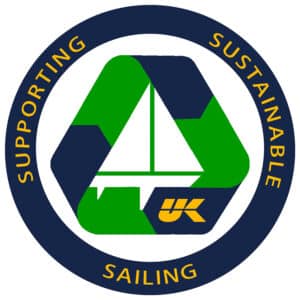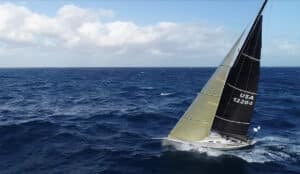It’s one of life’s truisms. You think you’re doing yourself a favor buying based on a low price…and you end-up disappointed when what you receive is low quality. This is particularly true with Dacron sails. Many cruising sailors opt for traditional Dacron sails over more expensive laminate sails because they like the all-white appearance of the sails and the cost savings. It’s when one starts reviewing their options with Dacron sails that questions arise. To put it bluntly, not all Dacron sailcloth is the same. By that, it’s not just the weight of the cloth, but rather it’s how the cloth is manufactured (materials and processing) that creates the differences.
To demonstrate the performance difference between high-quality and inexpensive Dacron sails, UK Sailmakers’ Head Designer Pat Considine conducted an FSI computer simulation (computer modeling using Fluid Structural Interactions) of high- and low-quality Dacron sails for a 36-footer. The first thing Pat found is that, from the very first time you sheet in a Dacron sail, it will begin to stretch. The question is “How much?”
Pat’s FSI analysis compares two crosscut mains and jibs when brand new. The only difference between the sails is the quality of the Dacron. The blue line shows the cross-sectional shape of the quality Dacron sail and the red is the inexpensive cloth. The data shows that the inexpensive Dacron sail stretched as much as a third more. Consider this differential as you project out five to ten seasons using the sail. You will enjoy sailing your boat more, when amortized over the life of the sail, the price differential of the quality sail is minimal on a per-season basis.
Many sailmakers will simply indicate a weight in ounces per sailmakers yard on a sail quote form. This article will show you why that is not enough information to be an informed consumer. Don’t think that all 7 oz. dacrons are the same.
There are three variables dictating the quality of a Dacron sailcloth. The first is the yarns used. Actual yarn variables include different modulus ratings (resistance to stretch) and high or low tenacity levels (actual breaking strength of the yarns). These yarns can vary in denier (thickness) and material composition. Larger denier (thicker) fibers do stretch a bit more, but they are more durable and are more resistant to damages from flexing and ultraviolet light. Small denier (thinner) fibers are more efficient as they have lower stretch characteristics, but they are also relatively more susceptible to UV damage and breakdown from flexing compared to thicker yarns.
The second variable is how the Dacron cloth is woven. It’s not just the thickness of the yarns, but how close are the warp and fill yarns? Does the sail need stronger yarns in the warp (horizontal) or and fill (vertical) direction? Most of the Dacron UK Sailmakers uses has more strength in either the warp or the fill depending on the sail being made. Fill-oriented cloth (stronger in the fill direction) is used for cross cut sails and warp-oriented cloth is used for radial cut sails. If the cloth is too strong in one direction, the sail will not age well. For instance, if the cloth is much stronger in the fill than the warp, the leech of the sail will not stretch, but as the warp yarns age the sail will grow deeper and the designed foil shape of the sail changes rapidly. While this is important to all sailors in terms of sail performance, it’s very critical to in mast roller furling sails where a “fat” sail will fail to roll smoothly into the mast extrusion after it becomes “baggy.”
The final variable is what finishing steps and coatings are applied to the woven cloth. Yarn selection and weave patterns are relatively quantitative factors. The artistry of Dacron sailcloth comes in the finishing processes. Adding finishes and coatings locks in the fibers and helps the finished cloth to be lower stretch. Adding specific coatings helps reduce stretch but can make smaller denier fibers easier to break – not necessarily more durable. Once a run of Dacron sailcloth comes off the loom, it goes through a series of heat, pressure, and coating applications. The heat blends and shrinks the cloth skin to the yarns creating a sandwich. Then the coatings and finishes are applied. The number of and characteristics of finishes applied will vary by sailcloth and will make as significant a difference between two Dacron sail cloths as the yarn weave structure.
OK, so what does this mean to the boat owner looking for new Dacron sails? Simply put, the better the quality of cloth used for a Dacron sail is directly related to the performance life of the sail—the ultimate satisfaction factor for a sail. When sails “blow out,” becoming fuller and losing their original aerodynamic shape, they don’t point as high and them make the boat heel more…not good things. You may pay more for a quality Dacron sail from UK Sailmakers than you would for a sail you purchased from a price-focused no-name sailmaker, but the higher levels of enjoyment and satisfaction the UK Sailmakers Dacron delivers outweighs any cost differential.
When you purchase your next new Dacron sail, don’t just buy it based on price. As this article explains, there are many kinds of 7 oz. Dacrons. For instance, Dimension-Polyant, the largest sail cloth manufacturer in the world makes five different dacron cloths that weight 7 ounces. From less expense to more:
-
308 Optimum Cruise
-
301 C-Breeze
-
320 All Purpose
-
310 Square Weave
-
344 Pro-Radial
When comparing price quotes, it is important to know what cloth is covered by the quote. Talk to your UK Sailmaker about what specific cloth to use in making our new sail. Remember, not all 7 oz dacrons are the same. Your UK Sailmaker can explain the differences; in the long run, value will be remembered long after price is forgotten.
Call UK Sailmakers and sail with confidence.




Good morning Pat,
We have to get together sometime soon. My friend Peter Heppel and I would love to discuss FSI and Dacron with you and your wonderful wife.
Let’s keep in touch, the new main sail that you made for me changed everything. My boat has never sailed so fast and so well in the 12 years that I’ve owned it. Your sails are terrific.
Lynda Lane
Good morning Pat,
We have to get together sometime soon. My friend Peter Heppel and I would love to discuss FSI and Dacron with you and your wonderful wife.
Let’s keep in touch, the new main sail that you made for me changed everything. My boat has never sailed so fast and so well in the 12 years that I’ve owned it. Your sails are terrific.
Lynda Lane
Good article as a new owner of a Capri 25 the boats typically use Dacron sails a big change from the mylar + sails I used on my Olsen 34. It’s good to know what to look for when purchasing a Dacron sail
Good article as a new owner of a Capri 25 the boats typically use Dacron sails a big change from the mylar + sails I used on my Olsen 34. It’s good to know what to look for when purchasing a Dacron sail
The red and blue lines probably meant something to Pat, but that single two-dimensional view meant nothing to me.
The red and blue lines probably meant something to Pat, but that single two-dimensional view meant nothing to me.
I’ve got a few quotes from sailmakers for a new sail, one material is called PBXS, and the other is called MT-307 does anyone know the difference. Cheers
I’ve got a few quotes from sailmakers for a new sail, one material is called PBXS, and the other is called MT-307 does anyone know the difference. Cheers